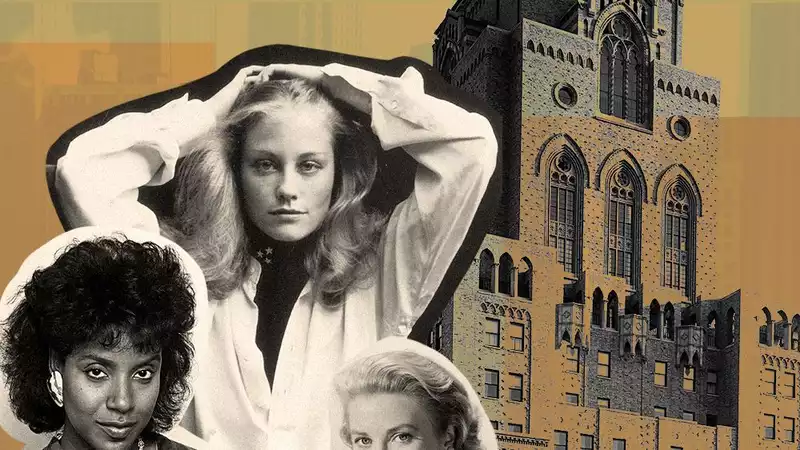
Prince Harry and Meghan Markle at the premiere of "Bob Marley: One Love" in Jamaica.
Prince Harry and Meghan Markle made a surprise red carpet appearance.The Duke and Duchess of Sussex were spotted at the premiere of the music biopic "...
Read More
From the Jazz Age to discotheques, the Barbizon Hotel was a haven for women seeking to escape their staid pasts and find an exciting and fulfilling Manhattan life. opened in 1928 at Lexington Avenue and 63rd Street, the "Dollhouse," as it later came to be called was a so-called "respectable" women's hotel, one of several in Manhattan. It was not a boarding house known at the time for its scratchy black horsehair sofas and tasteless communal dining tables, nor was it a seedy Victorian-style establishment, nor was it a co-ed hotel. According to this fascinating new book, The Barbizon: The Hotel That Set Women Free (opens in new tab), by historian Paulina Bullen, as the '20s passed, single women flocked to New York City in unprecedented numbers and, like their male counterparts, they were expected to pursue careers They expected to do the same. The Barbizon Hotel for Women advertised itself as the right place for young respectable career women to meet the right kind of people for the reasonable rate of $11 a week (about $165 today). Vanity Fair magazine (opens in new tab) called it a "classy fortress" with "the atmosphere of a fine convent." Prospective tenants needed three references and were rated according to their appearance, mannerisms, and style. Ali McGraw, Grace Kelly, Lauren Bacall, Liza Minnelli, Joan Didion, Cybill Shepherd, Candice Bergen, Sylvia Plath, and others went through.
In the pre-contraception era (the pill was legalized in 1965), there was a feeling in society that "nice" girls, and their chastity and reputation, had to be protected. And for many, that safe space was a 23-story building with a coral pink brick and sandstone facade decorated in Romanesque, Gothic, and Moorish styles. There were 700 rooms, each large enough to accommodate a single bed, a small easy chair, and a radio embedded in the wall, which was revolutionary at the time. Most rooms were dormitory-style, sharing a hallway bathroom. There was a library, a swimming pool, a gym, a rooftop garden, and a studio for painting and practicing arias. A modest entrance leading from the lobby led to a coffee shop, a bookstore, and a few other stores that one would expect a wealthy, well-bred woman to want. On the mezzanine floor above the lobby, women could check out their dates to be picked up. At afternoon tea, a woman played the pipe organ. The doormen at the gate and the cormorant-eyed ladies at the front desk were all very strict in enforcing the hotel's most important policy: no men were allowed on the second floor at any time of the day or night. After dark, even the elevator operators were women.
The Stork Club, one of the most famous nightclubs in mid-century Manhattan, invited Barbizon women to eat and drink for free. Barbizon (named after the French school of naturalist painting, which had an artistic ambiance) was also where the editors of the literary fashion magazine Mademoiselle decided to house the winners of their annual college guest editor program. Among the 1953 classmates included Plath, who dramatized the summer of 1953 in her classic feminist novel The Bell Jar (opens in new tab). She called the fictional hotel the Amazon. Plath ended this semi-autobiographical tale with a scene in which the heroine goes to a rooftop and dumps her prized wardrobe, which she had collected for her summer vacation as a fledgling magazine editor, into the Manhattan nightscape. After the Mademoiselle program, Plath left Barbizon and returned to her family home in Massachusetts.
The "Katie Gibbs Girls," who attended a white-glove secretarial school, booked a room. Ford Model sent a newcomer there. Grace Kelly was a clumsy brunette theater student with heavy glasses. Aspiring dancer Jaclyn Smith (TV's first "Charlie's Angels") was hanging out with model Dale Haddon. Cloris Leachman, who had just finished the Miss America pageant, stayed at the hotel on her way to stardom. Judy Garland is said to have frantically called the front desk to keep an eye on her daughter, Liza Minnelli. Presidential speechwriter Peggy Noonan also stayed there. Little Edie Beale (before she became famous at Grey Gardens) lived there from 1947 to 1952. Mademoiselle also brought in Joan Didion, Diane Johnson, Ali McGraw, Meg Wolitzer, and fashion designer Betsy Johnson.
Brenn's portrayal of Barbizon is strikingly white. She says that the first black woman to stay there was probably Barbara Chase-Riboud, who was also the first black Mademoiselle Visiting Editor in 1956. Chase-Riboud later became a prominent poet, writer, and artist. Phylicia Rashad was in residence in 1968 at the age of 16 with the prestigious Negro Ensemble Company, a groundbreaking theater company by and for blacks. It would have been interesting to learn more about the hotel's actual rules regarding women of all races. Race relations are somewhat omitted, although there is a joking reference to Chase-Riboud's alleged request by the editor of Mademoiselle magazine to be excluded from meetings with Southern advertisers and that she was not informed of the Barbizon Pool's existence. I would have liked to know the experiences of other women of color and minorities at Barbizon: were there only WASPs, or were there Jewish, Muslim, Italian American, and Asian women on the guest roster? Also, as Brenn's book states, one of the foundations of Barbizon's appeal is that it does not accept men. There is little to be said about the same-sex relationships of the guests. Were there ever openly gay women staying there?
In 1981, the hotel began to struggle financially and changed its policy to accept men. By that time, young women (and their families) were not likely to be concerned about their reputation. These emancipated women, who could only be accommodated in Barbizon, could have jobs, credit cards, bank accounts, and their own apartments. In 2005, after a change of owners, including Steve Rubel of Studio 54 nightclub fame and Ian Schrager, the building was transformed into a luxury condominium, housing Ricky Jarvais, the chairman of cat food Meow Mix chairman of the board of directors, and others came to live in the building.
Speaking of catty, in the book, Bren tells the story of "women" who could not leave Barbizon for the suburban split-level, penthouse apartment, or palace plus Prince Charming (in Grace Kelly's case, His Royal Highness Rainier III of Monaco) dream The story is told. The women with rent-controlled or stabilized apartments were not to be trifled with; Gael Greene, who stayed as guest editor of Mademoiselle in 1957 and later became restaurant critic for New York magazine, wrote in the New York Post that perhaps it was not possible to make a fortune She wrote an article for the New York Post about the "lonely women" who remained in Barbizon without ever making a fortune or having a family. Such remnant renters were eventually gathered in a deserted part of the building, where those who remained continue to live shabbily and solitarily to this day.
If you like Midge Maisel's and Peggy "Mad Men" Olson's glimpses of old New York, you will want to read this true story of a bygone New York.
.
Prince Harry and Meghan Markle made a surprise red carpet appearance.The Duke and Duchess of Sussex were spotted at the premiere of the music biopic "...
Read More
Taylor Swift is once again proving just how generous she is.At Sunday's Chiefs game at Highmark Stadium in Orchard Park, NY, the superstar made a grea...
Read More
Ken is not having a good day.Ryan Gosling is clearly pleased to have been nominated for Best Supporting Actor at the 2024 Academy Awards, but his achi...
Read More
Some A-listers like the wide open back of a black dress, but in Kendall Jenner's case, she likes the wide open front of a black dress (well, back, too...
Read More
Comments